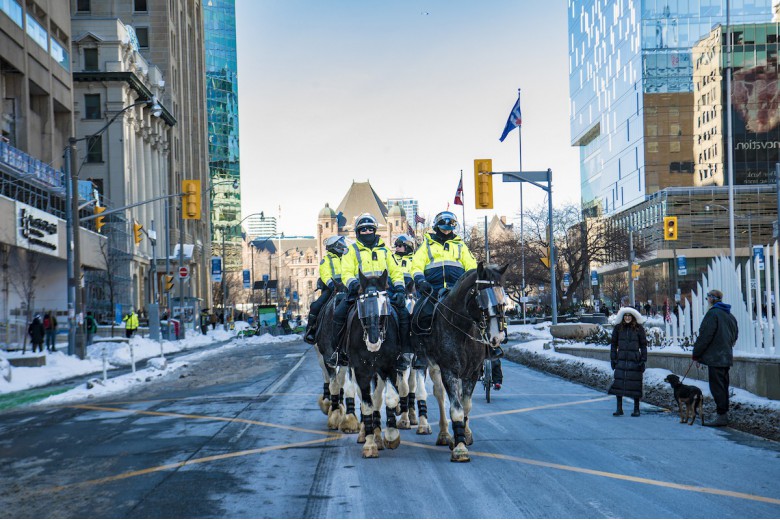To protect the Earth and climate that we all depend on, we must defund the police. We should start by defunding and dismantling the Community-Industry Response Group (C-IRG) – a secretive arm of the RCMP that works directly in service of extractive industries in British Columbia, including oil and gas, logging, and fish farming.
The C-IRG is brought in to enforce injunctions, take down blockades, and arrest land defenders. Since its inception in 2017, the C-IRG has been paid through the public purse to protect corporate interests. In doing this, it is accelerating the climate crisis and violating Indigenous Rights.
This is what I and my co-authors from Research for the Front Lines argued in our previous article about the C-IRG, which was published online by Briarpatch on November 3, 2021. In that first article, we described the horrifying violence the C-IRG uses to remove forest defenders like me from places like Fairy Creek. We interviewed C-IRG commander John Brewer, confirming that he ordered officers to remove their name tags and police badges – making them nearly impossible to identify and hold accountable for their actions. Using documents obtained by Wet’suwet’en land defenders through an access-to-information request, we also highlighted that over $18 million in public money has been spent between 2018 and 2021 to enforce Coastal GasLink’s injunction against the land defenders on Wet’suwet’en territory.
I wanted to know what the C-IRG’s mandate is, how officers are trained, and to whom they are accountable. I wanted to find out what we – land defenders trying to mitigate and repair the damage done to the planet – are up against.
I have spent most of the last year on the front lines at Fairy Creek and on Wet’suwet’en land, where the C-IRG is a constant presence. But when I went looking for details on the police force, I was shocked to learn that there was almost no publicly available information. I wanted to know what the C-IRG’s mandate is, how officers are trained, and to whom they are accountable. I wanted to find out what we – land defenders trying to mitigate and repair the damage done to the planet – are up against.
To try to find some answers, I joined forces with Research for the Front Lines, making phone calls, conducting interviews, and filing access-to-information requests.
In this article, we draw on interviews with C-IRG commander John Brewer, an anonymous source close to the C-IRG, and forest defenders at Fairy Creek to lay bare some of the historical context and present workings of the C-IRG. Here’s what we have found so far.
The history of the C-IRG
The founding of the C-IRG in 2017 coincided with increased organizing around issues related to land, resource extraction, settler colonialism, and the environment, especially on the land currently known as B.C. A number of movements contributed to a climate of increased Indigenous and environmental mobilization that precipitated the C-IRG’s creation: the Wet’suwet’en Nation’s resistance to the Coastal GasLink pipeline; several coastal First Nations’ protests against Enbridge’s Northern Gateway pipeline; Coast Salish Nations’ resistance to the Trans Mountain pipeline expansion; the Secwepemc Nation’s Tiny House Warriors; Idle No More; Treaty 8 First Nations’ protests against B.C. Hydro’s Site C hydroelectric dam; Justice for Missing and Murdered Indigenous Women, Girls, and Two-Spirit People; and the protests following the Mount Polley mine disaster.
Amid these growing social movements, E Division – the RCMP branch covering British Columbia – set out to streamline its policing of Indigenous-led resistance to industrial resource extraction.
In an interview with Research for the Front Lines, C-IRG Gold commander John Brewer explains why this happened, saying that before 2017, policing of what he calls “community-industry events” was “pretty haphazard.” Brewer, who notes that he’s been involved in policing such events for most of his career, explains that “we weren’t really learning from past events, we weren’t keeping that corporate knowledge, and we certainly weren’t ensuring that we had the right people in the right place at the right time.”
Amid these growing social movements, E Division – the RCMP branch covering British Columbia – set out to streamline its policing of Indigenous-led resistance to industrial resource extraction.
“I mean, you can go back to Ipperwash, right,” he adds. He’s referring to the deadly 1995 confrontation when Ontario Provincial Police killed Dudley George, a member of the Stony Point First Nation. George and other Stony Point members were asserting the community’s title over reserve land that had been stolen from them during the Second World War.
Asked about the founding of the C-IRG, Brewer explains, “A group of us said, why don’t we try to get together with a group of experienced people. Let’s share our knowledge and experience in a form of training.” The result was a police force – the Community-Industry Response Group, or C-IRG – that Brewer says exists to “support RCMP detachments and other partner agencies, and provide that enhanced policing response to protesters that are primarily concerned with that resource industry development, and ensure that we have [an] informed, consistent, measured, and an impartial approach.”
According to Brewer, the C-IRG has been deployed at Fairy Creek, where forest defenders are protecting ancient and sacred old-growth trees; on Wet’suwet’en territory, where land defenders are blocking the construction of the Coastal GasLink pipeline; at fish farms, where Indigenous activists have camped out to protect wild salmon populations; at the Site C hydroelectric dam, which local Indigenous Nations have opposed because it violates Treaty 8; and on Coast Salish territory at Burnaby Mountain and on Secwepemc territory, where land defenders are resisting the Trans Mountain pipeline expansion.
What is new, however, are some of the tools and techniques employed by the C-IRG today: media exclusion zones; pain compliance; stimming; the removal of name tags and police badges.
In short, even though Brewer and the C-IRG would never admit it, the C-IRG exists primarily to protect resource extraction where it might be impeded by Indigenous-led resistance.
There’s nothing new about that. Ever since the founding of the RCMP’s predecessor, the North West Mounted Police, Canadian police forces have worked diligently to remove and estrange Indigenous Peoples from their land. This required a constantly evolving set of government policies and institutions – from Métis scrip to residential schools – all with the same two end goals: to eliminate Indigenous Peoples and their ways of life and to secure unfettered settler access to land and resources.
What is new, however, are some of the tools and techniques employed by the C-IRG today: media exclusion zones; pain compliance; stimming; the removal of name tags and police badges; and even training in Indigenous cultural sensitivity, which creates the appearance of shifting away from oppression to reconciliation.
The C-IRG’s mandate and training today
The C-IRG is made up of RCMP officers who have volunteered to join the detachment. Temporarily transferred from their regular duties, Brewer says, “they come [from] across the board in policing, whether they’re uniform, traffic, plainclothes, doesn’t matter.” But not every officer who volunteers gets to join the C-IRG – Brewer says C-IRG officers are specially selected for their skills in self-sufficiency and “experience and knowledge in, obviously, Indigenous Rights and Title, experience dealing in industry, experience dealing with various levels of government.”
Through an interview with a source close to the C-IRG, we were able to learn more about the C-IRG’s recruitment and training. Fearing for his safety and privacy, the source spoke to our research team on the condition that we would not publish his name or the specifics of his relation to the C-IRG; however, the authors and Briarpatch’s editor have verified his identity.
The anonymous source says that money is a significant incentive to enlist in the C-IRG, with some officers earning $100 per hour and working 18.5-hour shifts. The Capital Daily reported that over the course of five months in 2021, the RCMP spent $3.75 million enforcing the court injunction at Fairy Creek – and $2.45 million of that, or 65 per cent, was spent on personnel.
Our source also reveals that officers are asked to join C-IRG: “They’ll send out an email, saying, ‘Hey, we need more C-IRG people.’” He adds that “when numbers [of C-IRG officers] can get really low, they would send officers there with no C-IRG training.”
The anonymous source says that money is a significant incentive to enlist in the C-IRG, with some officers earning $100 per hour and working 18.5-hour shifts.
He explains that when volunteers are prepped, they are sent to multiple days of training – previously four days, and now two days – where they watch and analyze videos of past protests and the associated police response. There, he says, C-IRG officers are also taught how to arrest Indigenous leaders and how to handle Indigenous cultural items. Officers are instructed to ask an arrestee if they would like to give a sacred item to another protester for safekeeping or put it in a box to be returned upon release.
The RCMP has long faced public scrutiny over its treatment of Indigenous community members and regalia during protests. During the Elsipogtog anti-shale gas protests in 2013, RCMP officers were seen – and, on occasion, caught on video – interfering in Mi’kmaw ceremonies, arresting Indigenous people in the midst of ceremony, and grabbing or mishandling sacred items, including drums and tobacco pipes. Seven years later, in 2020, the Civilian Review and Complaints Commission (CRCC) for the RCMP released a report which concluded that “the RCMP members assigned to the operation did not have sufficient training in Indigenous cultural matters” and recommended that “the RCMP should develop policy and a flexible procedure for the handling of sacred items secured during arrests at protests.”
But despite this new training that brings the C-IRG in line with the CRCC’s recommendations, land defenders report that C-IRG officers continue to disrespect Indigenous culture.
We spoke with Sleydo’ (also known as Molly Wickham), a spokesperson for the Gidimt’en Checkpoint, and Shay Lynn Sampson, a Gitxsan land defender, both of whom are opposing the Coastal GasLink pipeline through Wet’suwet’en territory. They report that the C-IRG and other RCMP detachments have blocked access to Wet’suwet’en lands, prevented them from engaging in cultural activities, and interrupted ceremony on multiple occasions.
“We just avoid certain parts of our territory when we want to go do cultural activities,” Sleydo’ explains. “The Elders have been terrified and scared and don’t actually even want to come out to the territory anymore because they don’t want to be surveilled and harassed by RCMP. So they’re violating our Indigenous Rights to access our own territory, to access our homes, to engage in our cultural activities, while they facilitate the destruction of our territory.”
Even though the C-IRG may now be more cautious about the optics of how they treat Indigenous people and objects, they exist to enforce colonial laws on stolen Indigenous Land. No amount of anti-oppression training can change that mandate.
The Coastal GasLink pipeline itself would destroy Wet’suwet’en medicine patches, hunting grounds, and trapping grounds.
Sleydo’ makes an important point: even though the C-IRG may now be more cautious about the optics of how they treat Indigenous people and objects, they exist to enforce colonial laws on stolen Indigenous Land. No amount of anti-oppression training can change that mandate.
The physical violence of the C-IRG has been well documented elsewhere: I described my violent arrest in the first article of this series; others have described police officers dragging Indigenous forest defenders by their braids, pepper spraying forest defenders’ genitals, and punching them in the face. What’s been less widely discussed is the C-IRG’s psychological warfare.
Our source close to the C-IRG says officers are directed to use a technique they call stimming: the use of repeated noises, lights, and other disturbances intended to unnerve or irritate protesters. “It’s kind of like a psychological game or warfare, where you turn bright lights on, turning the siren on, walk through the camps non-stop all night long so no one gets any sleep,” he says. “Keep people awake, keep people on edge, keep people agitated.” The goal is to create unrest, weaken the movement’s cohesion from the inside, and force forest defenders to leave the front lines. There is seemingly no limit to the types of harm the C-IRG is willing to inflict on protesters – not just physically while conducting arrests, but mentally, even while they’re trying to sleep.
In September 2021, Research for the Front Lines submitted 25 Access to Information requests including ones for the C-IRG's budgets for the last five years. In December, the week after this article went to print, we received replies from the RCMP's Access to Information and Privacy Branch, saying that they were unable to locate the budgets. For the budgets from 2017-2020, the replies added that "it is the policy of the RCMP and other federal government departments to dispose of records in accordance with a schedule established by the Librarian and Archivist of Canada. Any RCMP record that may have existed could have been purged in accordance to the above noted schedule." In other words, it's possible that C-IRG budgets – including very recent ones – have been destroyed as per RCMP policy. This is public money. Where is the accountability? Where is the possibility of public oversight?
How oil and gas became “critical infrastructure”
We can’t understand the increasing funding for and violence of the RCMP’s enforcement of resource extraction injunctions without first understanding the connection between resource extraction and critical infrastructure.
Critical infrastructure is a concept developed during the First World War to allow for certain industries, those deemed indispensable to the war effort, to garner protection from the state. During the Second World War and the Cold War, Defence of Canada Regulations allowed for the deployment of thousands of RCMP and militia officers for the protection of essential military, industrial, transport, and resource sites.
However, it was not until the mid-2000s that Canada would see government agencies begin to explicitly use the term. In doing so, they were mobilizing to protect resource extraction, transport, and storage sites from domestic threats, including what the security establishment refers to as “Aboriginal extremism.”
In 2015, when Bill C-51 was passed by the Harper government, becoming Canada’s Anti-terrorism Act, oil and gas infrastructure (including pipelines) became defined as critical infrastructure and, through this designation, resistance to fossil fuel extraction and transport became categorized as domestic terrorism.
In their book Policing Indigenous Movements, Andrew Crosby and Jeffrey Monaghan describe how the concept of critical infrastructure has been used to justify the surveillance and policing of Indigenous and environmental movements that involve civil disobedience and resistance to extraction projects. They cite a 2007 security briefing between the Canadian Security Intelligence Service (CSIS) and the Canadian Association of Petroleum Producers, which describes a move away “from national security to critical infrastructure protection” in the Canadian security establishment, involving increased intelligence sharing between corporate partners and federal surveillance agencies. “Ninety percent of what is considered critical infrastructure,” they explain, “(pipelines, nuclear stations, hydro dams, airports, etc.) is owned by private corporations,” which have become full policing partners in the sharing of information about resistance to extraction projects.
Oil and gas pipelines in Canada were labelled as critical infrastructure following the U.S. “war on terror,” which brought an expansion of the definition of terrorism to include any interference with Canada’s economic or financial stability. In 2015, when Bill C-51 was passed by the Harper government, becoming Canada’s Anti-terrorism Act, oil and gas infrastructure (including pipelines) became defined as critical infrastructure and, through this designation, resistance to fossil fuel extraction and transport became categorized as domestic terrorism.
As one of many examples, the protection of critical infrastructure was evoked in a leaked 2014 report entitled “Criminal Threats to the Canadian Petroleum Industry” by the RCMP’s Critical Infrastructure Intelligence Assessment Team, which cast the Coastal GasLink pipeline as critical to the well-being of Canadians and painted Wet’suwet’en land defenders and their supporters as members of fringe terrorist groups.
When critical infrastructure becomes the focus of protests, it is often protected by civil injunctions, which courts award to private companies to legally justify the removal and punishment of people who would stand in the way of industrial projects. Though Indigenous communities, governments, and companies can all apply for injunctions, a 2019 study by the Yellowhead Institute revealed vast imbalances in the number of injunctions awarded to each group. The study found that Canadian courts granted 90 per cent of injunctions filed by governments against First Nations, and 81 per cent of those filed by corporations against First Nations. The same courts granted only 18 percent of injunctions filed by First Nations against governments, and 19 per cent of those filed by First Nations against corporations.
“Ninety percent of what is considered critical infrastructure,” they explain, “(pipelines, nuclear stations, hydro dams, airports, etc.) is owned by private corporations,” which have become full policing partners in the sharing of information about resistance to extraction projects.
Most of the C-IRG’s work involves enforcing civil injunctions: they have enforced logging company Teal Cedar’s injunction at Fairy Creek; pipeline company Coastal GasLink’s injunction on Wet’suwet’en territory; and pipeline company Kinder Morgan’s injunction on Coast Salish territory.
Last year, David Gray-Donald published an article in Briarpatch called “Unpacking the Coastal GasLink injunction and its omissions.” In it, he explains how injunctions allow the courts to sidestep questions of Aboriginal Title and jurisdiction, even in cases where resource extraction occurs on Indigenous Lands – like those of the Wet’suwet’en Nation – that were never ceded or surrendered to Canada. Though the Supreme Court of Canada recognized the validity of Aboriginal Title in 1997, injunction law allows judges to consider cases in a vacuum, where settler industry is considered to have suffered “irreparable harm” if their project doesn’t go ahead soon, while the harm to Indigenous life, land, and culture is ignored.
Injunction law also allows judges to ignore environmental issues, which can form an important part of the defence for both Indigenous and non-Indigenous protesters. In the Fairy Creek injunction ruling in April, 2021, Justice Verhoeven, in awarding the injunction to Teal Cedar, wrote:
There is no doubt that climate change is real, and poses a grave threat to humanity’s future. [...] But as I have said, the effect of old growth forest logging on climate change and biodiversity is not before me, and is not for me to say. What is at stake in this Court is the maintenance of law and order and respect for the rule of law. The protestors are free to protest, demonstrate, and attempt to influence the government in any lawful way they may choose. But no one has the right to disobey a court order, no matter how passionately they may believe in their cause.
A group of children walk through a clear cut on Pacheedaht territory on May 29, 2021. The children were part of a gathering at Fairy Creek at the invitation of Pacheedaht Elder Bill Jones.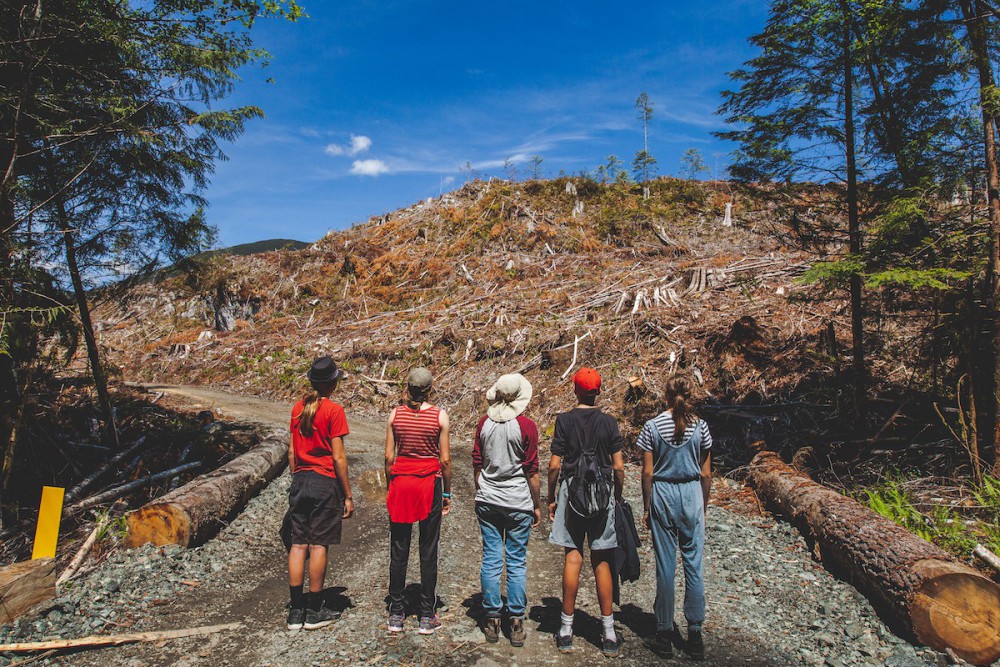
Discrediting land and water protection movements
As resource extraction became “critical infrastructure” and protesters became “domestic terrorists,” police officers’ training and ideology has had to keep up.
In a recent article published in the journal Settler Colonial Studies, researcher Andrew Crosby notes that in police reports, Indigenous political grievances are dismissed “within stereotypical tropes of Native greed, of acting out of individual self-interest.” As Crosby explains, “security officials deploy designations such as ‘factions’ or ‘splinter groups’ to marginalize and delegitimize those community members seen as acting outside the authority of the band council system.” This is one of the ways that industry and their allies, the police, discredit Indigenous movements.
Another example of the discrediting of land defenders’ motivations was offered by the anonymous source close to the C-IRG. He explains that officers are taught, during C-IRG training sessions, that land defence actions like the Wet’suwet’en and Fairy Creek blockades are led by professional protesters who are funded by U.S. resource extraction companies and sent in to undermine Canadian competition. He explains that officers are told that “these organizations in the States would hire people, or fund people to go up to Canada, and use Indigenous people to cause protests and shut down those things from being developed in Canada for the sole purpose of not having that competition in the marketplace.”
He adds that in order to buttress this idea, the training goes “into some of the intelligence on what they call ‘professional protesters’ that travel around the world or countries and just show up at protest groups to stir things up, kind of get local people arrested, and then they kind of sneak out the back door while the locals are getting arrested for all this stuff they stirred up.”
He explains that officers are told that “these organizations in the States would hire people, or fund people to go up to Canada, and use Indigenous people to cause protests and shut down those things from being developed in Canada for the sole purpose of not having that competition in the marketplace.”
This conspiracy theory of “U.S.-funded activists sabotaging Canadian oil” has long been used by the oil and gas industry to cast suspicion on local environmental movements. Vivian Krause, a B.C.-based researcher (who receives copious funding from the resource extraction sector), has spearheaded this myth, claiming that U.S. industry funders have contributed millions to Canadian environmental and Indigenous groups between 2009 and 2017 in order “to push Canada out of the global oil market.”
Scholars including Andrew Leach, an energy and environmental economist at the University of Alberta, have cast doubt on Krause’s narrative, pointing out that only a tiny fraction of U.S. funding to Canadian environmental organizations goes to anti-pipeline and anti-tarsands campaigns. But it was Krause’s research that inspired Alberta Premier Jason Kenney’s $3.5 million inquiry into “anti-Alberta energy” campaigns and their foreign funding.
She’s also a favourite of oil and gas industry lobby groups like the Canadian Association of Petroleum Producers, which reposted a video of Krause being interviewed by Global News Edmonton on their website and added the following caption: “According to Krause, these groups are funding anti-Canadian oil campaigns with the specific goal of land-locking oil production from Western Canada. The ultimate effect is to prevent pipelines from being built, which serves U.S. interests where production continues to expand, while driving down the price for Alberta oil, costing Canadians billions of dollars in foregone revenue.”
“The C-IRG in Fairy Creek was not impartial,” he says. “There were many instances where they worked directly with industry, 100 per cent.”
The fact that C-IRG training explicitly parrots these industry talking points is concerning, as it points to collusion between the oil and gas industry and an allegedly “impartial” police force.
And when it comes to flashpoints like those at Fairy Creek or the Wet’suwet’en blockades, this idea not only reduces Indigenous people to mere puppets of fictitious foreign terrorists, but it also delegitimizes Indigenous resistance in the eyes of the police officers themselves. Our source with insider knowledge says that instead of seeing the reality – “that Indigenous sovereignty is being trampled on” – C-IRG officers are taught “that there’s a professional protester, who’s being funded by some massive corporation in the States or somewhere, who’s stirred this all up to crush our Canadian economy and [C-IRG officers are] here to fix it.”
RCMP-industry collusion
Despite Brewer’s repeated claims that the C-IRG takes a “measured” or “impartial” approach, their actions tell a different story.
Our source close to the C-IRG says that officers are trained “to be indifferent to industry and to be indifferent to the local people, protesters, whoever. They are just there to keep the peace. And people can protest lawfully, and industry can work – and they’re there to keep the peace between the two.”
But, he adds, “That, to me, really changed in Fairy Creek.”
“The C-IRG in Fairy Creek was not impartial,” he says. “There were many instances where they worked directly with industry, 100 per cent.”
We interviewed Fairy Creek forest defenders who had observed the RCMP working directly with industry. All of them asked to remain anonymous or to use a pseudonym, fearful of retaliation and criminalization by the RCMP. The authors have verified their identities.
One forest defender, who asked to remain anonymous, says he watched the RCMP and industry drive up to a roadblock together and use industry trucks as the exclusion line – preventing other protesters or media from entering the area and preventing other vehicles from leaving. “They drove up together, came out together, cops arrested us, directed industry guys to pull their trucks up to block [the road],” he explains.
“He shouted to one of the green guys [the RCMP Emergency Response Team, who wear green military-style uniforms], ‘Hey, I got one, are you coming to get her?’ and then eventually the RCMP officer came and properly arrested me.”
Another forest defender, who also asked to remain anonymous, describes an interaction that took place in August 2021, when industry personnel driving excavators destroyed the camps that protesters had been using to cook and sleep in. She says protesters’ belongings were placed in industry vehicles and taken first to the Teal-Jones yard, about 50 kilometres from the blockade location on the way to Lake Cowichan, where they were sorted, then taken to the dump in Duncan. Hoping to rescue personal belongings and important camp infrastructure, she and a friend attempted to follow these trucks by car. A cop car pulled out between the industry trucks full of belongings and the car in which the two forest defenders were driving. “When the trucks left and we headed out in the same direction I was pulled over and detained. They took my driver’s licence and told me I was not allowed to drive in that direction,” our source says. She and her friend were held on the side of the road for over 45 minutes before they were allowed to leave. When they got to the dump they found the medic tent and other gear in the dumpsters.
Another account comes from a forest defender who, at the blockade, goes by the name Sassafras. She was in an active cutblock – an area that has been sectioned off to be logged by Teal-Jones – in early September 2021. Along with a few other forest defenders, she was running and blowing an air horn to try and prevent the loggers from cutting down ancient trees. “I got chased down by a logger and he grabbed me and pinned me down and held me there for less than five minutes,” she says. “He shouted to one of the green guys [the RCMP Emergency Response Team, who wear green military-style uniforms], ‘Hey, I got one, are you coming to get her?’ and then eventually the RCMP officer came and properly arrested me.”
“It’s all about making sure we adhere to the goal of the measured approach, which is to make sure that we always de-escalate,” Brewer tells Research for the Front Lines. But using industry trucks to mark the exclusion line, collaborating with industry to steal and discard personal belongings, and permitting loggers to pin down forest defenders until police arrive on the scene is not a measured, unbiased approach.
These police actions amount to serious violations of the RCMP’s own code of professional conduct, which dictates that members must “avoid any actual, apparent or potential conflicts of interest.” On these and many other occasions, the C-IRG has demonstrated a deep-seated bias in favour of industry, using police powers to aid private resource extraction. The anonymous source close to C-IRG says as much, adding, “The C-IRG was made to be like a quick response team for industry.”
A forest defender is arrested by RCMP officers after tossing a bottle of water to people who had been pepper sprayed on the other side of the orange gate.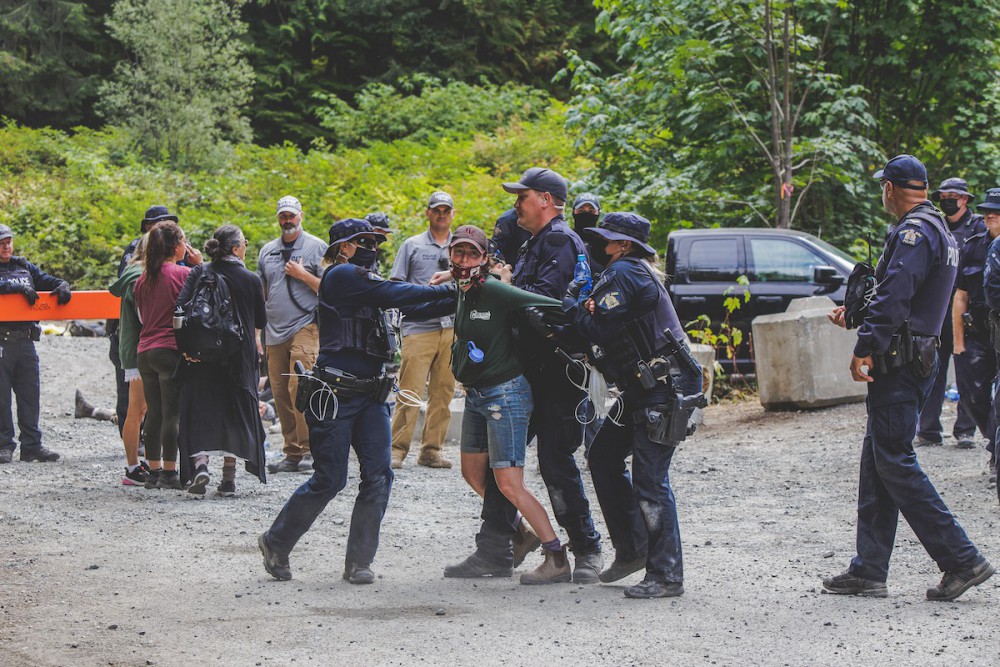
The antidote to climate denial is climate action
As the late Arthur Manuel, a Secwepemc thinker and political leader, wrote, “For Indigenous people in Canada, the colonial law enforcer meets us at every turn. […] If we try to keep resource extractors from moving onto our lands, injunctions against us are quickly awarded and the police swoop in for mass arrests. Canadian jails are full of our young men and women. That is colonialism. That is oppression.”
Ultimately, the C-IRG is part of a larger effort by the Canadian state to delay and deny meaningful climate action and Indigenous Land Rights. The rule of law is not about protecting people; it is more about protecting the economic interests of the elite.
Our best hope, our most powerful force in the fight for a livable and just world, is ordinary people who are willing to put their bodies on the line to protect the lands, waters, and communities they love.
If we follow the C-IRG’s mandate – of enforcing industry access to Indigenous Land – to its logical conclusion, we can foresee a time in the not-so-distant future when extractive industry has razed the last remaining old-growth forests in Canada, when networks of pipelines have been built to pump Alberta bitumen to overseas markets, when the carbon emitted from the expanding tarsands has hurled the living world into ecological and social collapse. This is the future the C-IRG is ushering into being.
We are the counterforce to that. Our best hope, our most powerful force in the fight for a livable and just world, is ordinary people who are willing to put their bodies on the line to protect the lands, waters, and communities they love.
And so, in light of all that we’ve learned about the C-IRG, we offer the following three calls to action. We must take up these and other strategies in order to defund, delegitimize, and dismantle Canada’s systems of oppression, starting with the C-IRG.
Refuse to let Canada use our tax dollars to enforce extractivism and violate Indigenous Rights.
C-IRG is paid for through a 70:30 cost-share agreement between the provincial and federal government. In other words, our tax dollars are being used to further private, corporate interests. It’s essential to stop the flow of money to industry’s mercenaries.
Tax resistance, a form of direct action used in movements from anti-war to women’s suffrage, is the refusal to pay taxes in protest of certain unjust uses of tax revenue. As the next tax season approaches, Research for the Front Lines will be working with others to develop a template letter to be sent along with, or in lieu of tax returns, expressing our objection to having our income tax spent on ecocidal and genocidal policing such as that of the C-IRG. We invite you to follow us on social media (@RsrchFrontLines on Twitter, and Research for the Front Lines on Facebook) to receive an update when we release the template letter.
Uphold Indigenous authority and laws wherever you reside.
If the Canadian state does not protect or respect the lives and places you love, if in fact it is actively threatening them, there are other laws and authorities you can choose to respect and uphold. At a conference in 2020, Métis artist Christi Belcourt offered the following invitation:
Push for laws to be changed to recognize the collective Indigenous land ownership. … Recognize the authority of Indigenous people in their territories and this means the full authority to make complete decisions. … Start to follow Indigenous laws and protocols within your territories where you live and this includes in cities and towns. … There are Indigenous laws and protocols that exist where you live and so it’s just a matter of researching and finding out what those are. Indigenous people have laws that are thousands of years old, get to know them.
Join the front lines.
The Canadian state has incredible power and resources at its command, which it uses to enforce the will of industry. The power we can wield to push back against the power of the state is people power: the power of mass civil disobedience and direct action, the power of people standing up and using our skills and our bodies to block destruction and defend what we love. Over the past decade, Indigenous-led resistance to fossil fuel projects in Canada and the U.S. has halted an estimated 1.587 billion metric tons of annual greenhouse gas emissions – more pollution than is produced by all vehicles currently on the road in these countries.
But we need more people to join the front lines. In too many cases, despite fierce resistance, ancient forests are being cut to the ground and pipelines are being drilled under sacred rivers. We can afford to be neither passive bystanders nor dispassionate researchers. Front-line communities and grassroots movements are protecting people and the planet through tireless and incredibly risky work. But to tip the balance of power, resistance needs to involve more of us. This moment in history calls everyone to join the front lines, like our lives depend on it.
Update, January 5, 2022: After this article was published in print, the authors received a response to their Access to Information requests for the C-IRG's budgets. Details about the RCMP's response to these ATI requests do not appear in print, and have been added to the online version of this article.


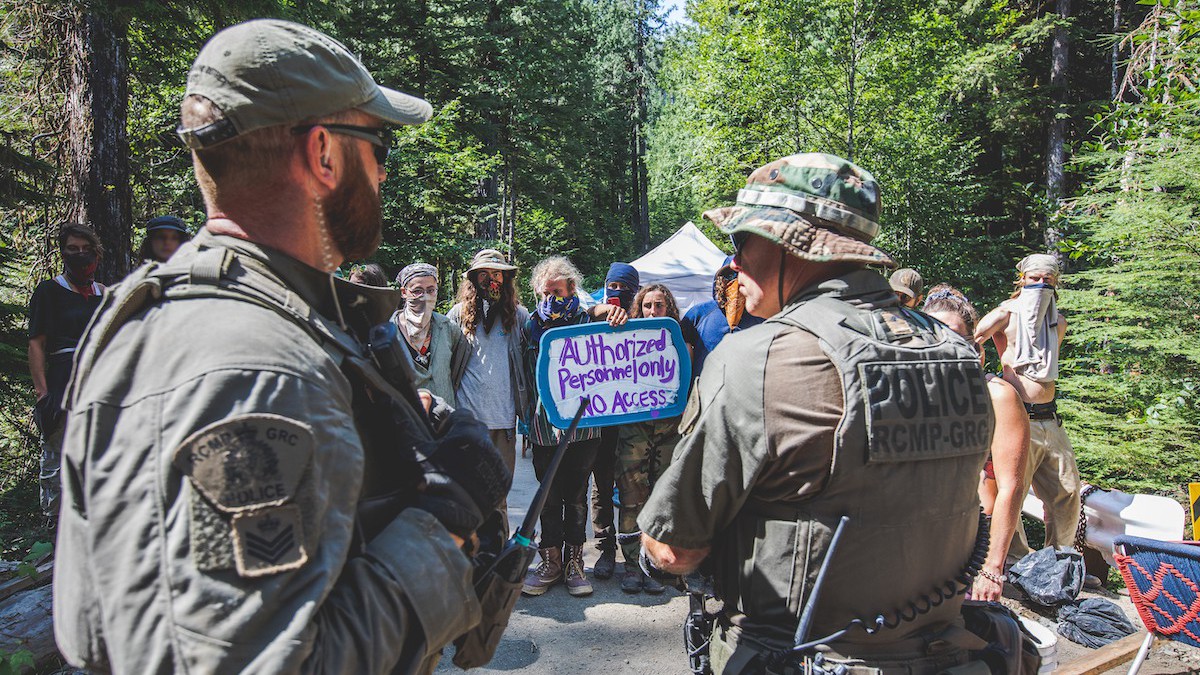
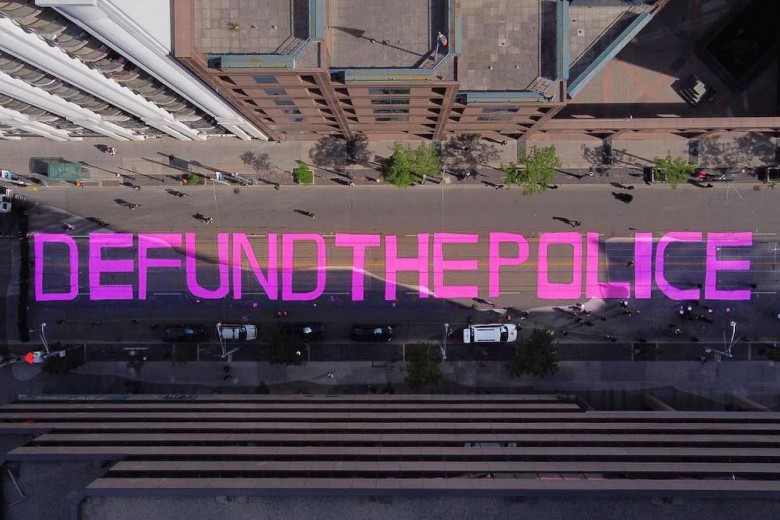
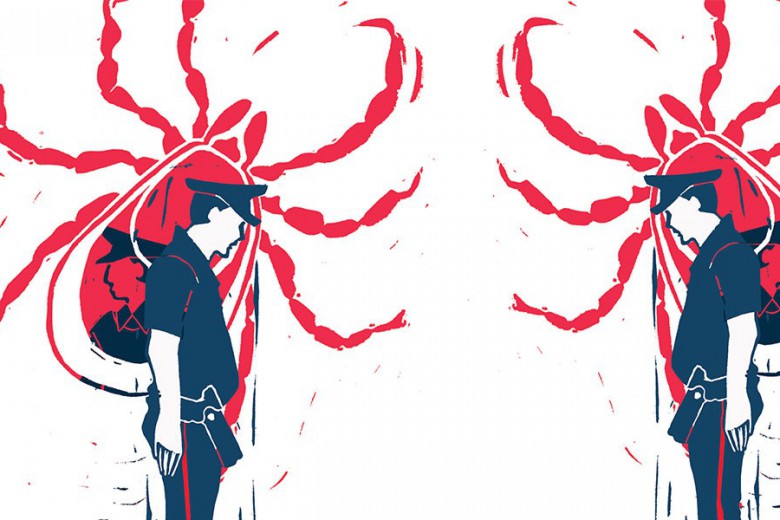
_780_520_90_s_c1.jpg)
